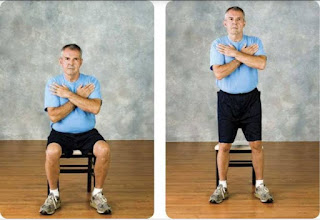SPEED, ITS TYPES & METHOD TO DEVELOP.
Speed plays a vital role in almost each and every game. Speed is the ability to move from one place to another in the shortest possible time.
According to Barrow & McGee speed is the capacity of an individual to perform successive movement of same pattern at a fast rate.
Types of speed -:
Speed appears in different form in different sports. The main forms in which speed appears are stated below:
1. Reaction Ability -
Reaction ability depends completely on coordinative processes. So, it is also considered a coordinative ability. It is the ability to react effectively and quickly to any action or signal. In games and sports reaction ability is not only significant in order to react quickly to a signal but the reaction should also be accurate according to situation.
Reaction ability is further divided into two categories:-
A. Simple Reactions Ability - It is the ability to react quickly in already determined manner to known signal.
Ex - Reaction of a sprinter in start of sprint races is already known to racer.
B. Complex Reaction Ability - It is the ability to react quickly and accurately to to undermined or unexpected signals. These signals are and expected for sports person because he or she does not know when and to which signal he or she has to react.
Ex - Facing a ball in cricket by batsman.
2. Acceleration Ability -
It is the ability to achieve maximum speed from a stationary position or from low speed state. Generally sprinters achieve their maximum speed after approximately six seconds. This ability mainly depends upon explosive strength, technique and flexibility. This ability is important in all games and sports in which maximum speeds are to be achieved quickly.
Ex - sprint races, swimming, hockey, etc.
3. Movement Speed -
It is the ability to do a movement in a minimum time. It depends upon technique, explosive strength, flexibility and coordinator abilities. It can be measured by the time taken to complete the movement.
Ex - boxing, wrestling, throws, jumps, etc.
4. Locomotor Ability -
It is the ability to maintain maximum speed for maximum time and distance for stop this ability is significant in only a few sport events at 100metre, 200 metre, 400 metre race, short sprint in track cycling, speed skating, etc.
5. Speed Endurance -
Speed endurance is the ability to perform moments with high-speed under conditions of fatigue. Speed endurance is complicated ability which depends upon explosive strength, speed and endurance. It also depends upon technique, local muscular endurance and lactic acid tolerance ability.
Methods to develop speed -
It is a fact that speed is product of genetic and environmental factors. Regarding the genetic factor nothing can be changed. As a matter of fact, each individual has a fast twitch fibres (white fibres) and slow twitch fibres(red fibres). If an individual has more percentage of fast twitch fibres his movement will be faster full stop on the other hand if an individual has more percentage of slow twitch fibres he or she will have more endurance or stamina. The percentage of these muscle fibres cannot be changed. So it means that genetic factor sets the limit of speed of an individual upto certain level but environmental factor still plays an important role. In fact central nervous system, muscular strength, flexibility, etc can affect speed of an individual.
Methods used for development of speed are:-
1. Acceleration Speed -
Acceleration run are usually adopted to develop Eid special in attaining maximum speed from stationary position. It should be kept in mind that the technique of any event should be learnt in the beginning.  Only then we should switch over to acceleration runs. For acceleration run an athlete is required to run a specific distance. He or she takes start from the starting line and tries to attain maximum speed as soon as possible and finished the distance specified at that speed. This accelerated runs are repeated over and over again with sufficient intervals between runs. Printers usually achieved their maximum speed in 6 seconds after stationary position.
Only then we should switch over to acceleration runs. For acceleration run an athlete is required to run a specific distance. He or she takes start from the starting line and tries to attain maximum speed as soon as possible and finished the distance specified at that speed. This accelerated runs are repeated over and over again with sufficient intervals between runs. Printers usually achieved their maximum speed in 6 seconds after stationary position.
 Only then we should switch over to acceleration runs. For acceleration run an athlete is required to run a specific distance. He or she takes start from the starting line and tries to attain maximum speed as soon as possible and finished the distance specified at that speed. This accelerated runs are repeated over and over again with sufficient intervals between runs. Printers usually achieved their maximum speed in 6 seconds after stationary position.
Only then we should switch over to acceleration runs. For acceleration run an athlete is required to run a specific distance. He or she takes start from the starting line and tries to attain maximum speed as soon as possible and finished the distance specified at that speed. This accelerated runs are repeated over and over again with sufficient intervals between runs. Printers usually achieved their maximum speed in 6 seconds after stationary position.2. Pace Runs or Races -
Pace races means running the whole distance of a race at a constant Speed. In pace races an athlete runs the race with uniform speed, generally 800m and above races are included in pace races.
As a matter of fact an athlete can run a distance of 300 metres at full speed. So in longer receive such as 800 metre on above races he or she must conserve his energy by reducing his speed for the left over distance. The middle and long distance races must be run keeping the page in mind in the beginning of such races the first part of the race should not be run too fast, otherwise, you cannot complete the race.
As a matter of fact an athlete can run a distance of 300 metres at full speed. So in longer receive such as 800 metre on above races he or she must conserve his energy by reducing his speed for the left over distance. The middle and long distance races must be run keeping the page in mind in the beginning of such races the first part of the race should not be run too fast, otherwise, you cannot complete the race.
Generally, novice athletes do not run a race in such a way. That is why, they get tired after completing approximately half distance of the race and finally leaves the race.
Thankyou for visiting







Comments